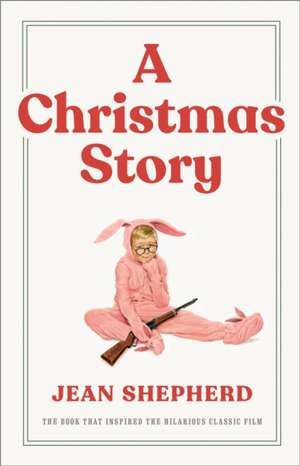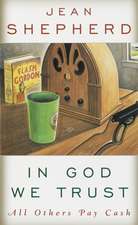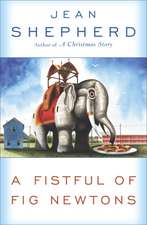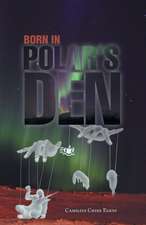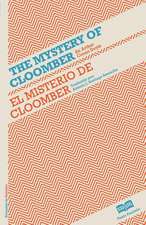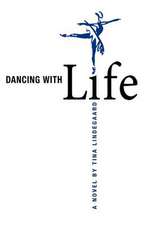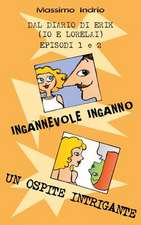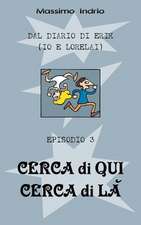A Christmas Story: The Book That Inspired the Hilarious Classic Film
Autor Jean Shepherden Limba Engleză Hardback – 30 sep 2003
The holiday film A Christmas Story, first released in 1983, has become a bona fide Christmas perennial, gaining in stature and fame with each succeeding year. Its affectionate, wacky, and wryly realistic portrayal of an American family’s typical Christmas joys and travails in small-town Depression-era Indiana has entered our imagination and our hearts with a force equal to It’s a Wonderful Life and Miracle on 34th Street.
This edition of A Christmas Story gathers together in one hilarious volume the gems of autobiographical humor that Jean Shepherd drew upon to create this enduring film. Here is young Ralphie Parker’s shocking discovery that his decoder ring is really a device to promote Ovaltine; his mother and father’s pitched battle over the fate of a lascivious leg lamp; the unleashed and unnerving savagery of Ralphie’s duel in the show with the odious bullies Scut Farkas and Grover Dill; and, most crucially, Ralphie’s unstoppable campaign to get Santa—or anyone else—to give him a Red Ryder carbine action 200-shot range model air rifle. Who cares that the whole adult world is telling him, “You’ll shoot your eye out, kid”?
The pieces that comprise A Christmas Story, previously published in the larger collections In God We Trust, All Others Pay Cash and Wanda Hickey’s Night of Golden Memories, coalesce in a magical fashion to become an irresistible piece of Americana, quite the equal of the film in its ability to warm the heart and tickle the funny bone.
Preț: 95.70 lei
Nou
Puncte Express: 144
Preț estimativ în valută:
18.31€ • 19.16$ • 15.21£
18.31€ • 19.16$ • 15.21£
Carte disponibilă
Livrare economică 12-26 martie
Preluare comenzi: 021 569.72.76
Specificații
ISBN-13: 9780767916226
ISBN-10: 0767916220
Pagini: 144
Dimensiuni: 135 x 198 x 17 mm
Greutate: 0.23 kg
Ediția:1
Editura: BROADWAY BOOKS
ISBN-10: 0767916220
Pagini: 144
Dimensiuni: 135 x 198 x 17 mm
Greutate: 0.23 kg
Ediția:1
Editura: BROADWAY BOOKS
Notă biografică
For many years a cult radio and cabaret personality in New York City, JEAN SHEPHERD was the creator of the popular film A Christmas Story, which is based on his novels In God We Trust, All Others Pay Cash and Wanda Hickey’s Night of Golden Memories, and which has become a holiday tradition on the Turner Network. Jean Shepherd passed away in 1999.
Extras
DUEL IN THE SNOW, OR RED RYDER NAILS THE CLEVELAND STREET KID
DISARM THE TOY INDUSTRY
Printed in angry block red letters the slogan gleamed out from the large white button like a neon sign. I carefully reread it to make sure that I had not made a mistake.
DISARM THE TOY INDUSTRY
That's what it said. There was no question about it.
The button was worn by a tiny Indignant-type little old lady wearing what looked like an upturned flowerpot on her head and, I suspect (viewing it from this later date) a pair of Ked tennis shoes on her feet, which were primly hidden by the Automat table at which we both sat.
I, toying moodily with my chicken pot pie, which of course is a specialty of the house, surreptitiously examined my fellow citizen and patron of the Automat. Wiry, lightly powdered, tough as spring steel, the old doll dug with Old Lady gusto into her meal. Succotash, baked beans, creamed corn, side order of Harvard beets. Bad news--a Vegetarian type. No doubt also a dedicated Cat Fancier.
Silently we shared our tiny Automat table as the great throng of pre-Christmas quick-lunchers eddied and surged in restless excitement all around us. Of course there were the usual H & H club members spotted here and there in the mob; out-of-work seal trainers, borderline bookies, ex-Opera divas, and panhandlers trying hard to look like Madison Avenue account men just getting out of the cold for a few minutes. It is an Art, the ability to nurse a single cup of coffee through an entire ten-hour day of sitting out of the biting cold of mid-December Manhattan.
And so we sat, wordlessly as is the New York custom, for long moments until I could not contain myself any longer.
"Disarm the Toy Industry?" I tried for openers.
She sat unmoved, her bright pink and ivory dental plates working over a mouthful of Harvard beets, attacking them with a venom usually associated with the larger carnivores. The red juice ran down over her powdered chin and stained her white lace bodice. I tried again:
"Pardon me, Madam, you're dripping."
"Eh?"
Her ice-blue eyes flickered angrily for a moment and then glowed as a mother hen's looking upon a stunted, dwarfed offspring. Love shone forth.
"Thank you, sonny."
She dabbed at her chin with a paper napkin and I knew that contact had been made. Her uppers clattered momentarily and in an unmistakably friendly manner.
"Disarm the Toy Industry?" I asked.
"It's an outrage!" she barked, causing two elderly gentlemen at the next table to spill soup on their vests. Loud voices are not often heard in the cloistered confines of the H & H.
"It's an outrage the way the toymakers are forcing the implements of blasphemous War on the innocent children, the Pure in Spirit, the tiny babes who are helpless and know no better!"
Her voice at this point rising to an Evangelical quaver, ringing from change booth to coffee urn and back again. Four gnarled atheists three tables over automatically, by reflex action alone, hurled four "Amen's" into the unanswering air. She continued:
"It's all a Government plot to prepare the Innocent for evil, Godless War! I know what they're up to! Our Committee is on to them, and we intend to expose this decadent Capitalistic evil!"
She spoke in the ringing, anvil-like tones of a True Believer, her whole life obviously an unending fight against They, the plotters. She clawed through her enormous burlap handbag, worn paperback volumes of Dogma spilling out upon the floor as she rummaged frantically until she found what she was searching for.
"Here, sonny. Read this. You'll see what I mean." She handed me a smudgy pamphlet from some embattled group of Right Thinkers, based--of course--in California, denouncing the U.S. as a citadel of Warmongers, profit-greedy despoilers of the young and promoters of world-wide Capitalistic decadence, all through plastic popguns and Sears Roebuck fatigue suits for tots.
She stood hurriedly, scooping her dog-eared library back into her enormous rucksack and hurled her parting shot:
"Those who eat meat, the flesh of our fellow creatures, the innocent slaughtered lamb of the field, are doing the work of the Devil!"
Her gimlet eyes spitted the remains of my chicken pot pie with naked malevolence. She spun on her left Ked and strode militantly out into the crisp, brilliant Christmas air and back into the fray.
I sat rocking slightly in her wake for a few moments, stirring my lukewarm coffee meditatively, thinking over her angry, militant slogan.
DISARM THE TOY INDUSTRY
A single word floated into my mind's arena for just an instant--"Canal water!"--and then disappeared. I thought on: As if the Toy industry has any control over the insatiable desire of the human spawn to own Weaponry, armaments, and the implements of Warfare. It's the same kind of mind that thought if making whiskey were prohibited people would stop drinking.
I began to mull over my own youth, and, of course, its unceasing quest for roscoes, six-shooters, and any sort of blue hardware--simulated or otherwise--that I could lay my hands on. It is no coincidence that the Zip Green was invented by kids. The adolescent human carnivore is infinitely ingenious when confronted with a Peace movement.
Outside in the spanking December breeze a Salvation Army Santa Claus listlessly tolled his bell, huddled in a doorway to avoid the direct blast of the wind. I sipped my coffee and remembered another Christmas, in another time, in another place, and . . . a gun.
I remember clearly, itchingly, nervously, maddeningly the first time I laid eyes on it, pictured in a three-color, smeared illustration in a full-page back cover ad in Open Road For Boys, a publication which at the time had an iron grip on my aesthetic sensibilities, and the dime that I had to scratch up every month to stay with it. It was actually an early Playboy. It sold dreams, fantasies, incredible adventures, and a way of life. Its center foldouts consisted of gigantic Kodiak bears charging out of the page at the reader, to be gunned down in single hand-to-hand combat by the eleven-year-old Killers armed only with hunting knife and fantastic bravery.
Its Christmas issue weighed over seven pounds, its pages crammed with the effluvia of the Good Life of male Juvenalia, until the senses reeled and Avariciousness, the growing desire to own Everything, was almost unbearable. Today there must be millions of ex-subscribers who still can't pass Abercrombie & Fitch without a faint, keening note of desire and the unrequited urge to glom on to all of it. Just to have it, to feel it.
Early in the Fall the ad first appeared. It was a magnificent thing of balanced copy and pictures, superb artwork, and subtly contrived catch phrases. I was among the very first hooked, I freely admit it.
BOYS! AT LAST YOU CAN OWN AN OFFICIAL RED RYDER CARBINE ACTION TWO-HUNDRED SHOT RANGE MODEL AIR RIFLE!
This in block red and black letters surrounded by a large balloon coming out of Red Ryder's own mouth, wearing his enormous ten-gallon Stetson, his jaw squared, staring out at me manfully and speaking directly to me, eye to eye. In his hand was the knurled stock of as beautiful, as coolly deadly-looking a piece of weaponry as I'd ever laid eyes on.
YES, FELLOWS. . . .
Red Ryder continued under the gun:
YES, FELLOWS, THIS TWO-HUNDRED-SHOT CARBINE ACTION AIR RIFLE, JUST LIKE THE ONE I USE IN ALL MY RANGE WARS CHASIN' THEM RUSTLERS AND BAD GUYS CAN BE YOUR VERY OWN! IT HAS A SPECIAL BUILT-IN SECRET COMPASS IN THE STOCK FOR TELLING THE DIRECTION IF YOU'RE LOST ON THE TRAIL, AND ALSO AN OFFICIAL RED RYDER SUNDIAL FOR TELLING TIME OUT IN THE WILDS. YOU JUST LAY YOUR CHEEK 'GAINST THIS STOCK, SIGHT OVER MY OWN SPECIAL DESIGN CLOVERLEAF SIGHT, AND YOU JUST CAN'T MISS. TELL DAD IT'S GREAT FOR TARGET SHOOTING AND VARMINTS, AND IT WILL MAKE A SWELL CHRISTMAS GIFT!!
The next issue arrived and Red Ryder was even more insistent, now implying that the supply of Red Ryder BB guns was limited and to order now or See Your Dealer Before It's Too Late!
It was the second ad that actually did the trick on me. It was late November and the Christmas fever was well upon me. I thought about a Red Ryder air rifle in all my waking hours, seven days a week, in school and out. I drew pictures of it in my Reader, in my Arithmetic book, on my hand in indelible ink, on Helen Weathers' dress in front of me, in crayon. For the first time in my life the initial symptoms of genuine lunacy, of Mania, set in.
I imagined innumerable situations calling for the instant and irrevocable need for a BB gun, great fantasies where I fended off creeping marauders burrowing through the snow toward the kitchen, where only I and I alone stood between our tiny huddled family and insensate Evil. Masked bandits attacking my father, to be mowed down by my trusted cloverleaf-sighted deadly weapon. I seriously mulled over the possibility of an invasion of raccoons, of which there were several in the county. Acts of selfless Chivalry defending Esther Jane Alberry from escaped circus tigers. Time and time again I saw myself a miraculous crack shot, picking off sparrows on the wing to the gasps of admiring girls and envious rivals on Cleveland Street. There was one dream that involved my entire class getting lost on a field trip in the swamps, wherein I led the tired, hungry band back to civilization, using only my Red Ryder compass and sundial. There was no question about it. Not only should I have such a gun, it was an absolute necessity!
Early December saw the first of the great blizzards of that year. The wind howling down out of the Canadian wilds a few hundred miles to the north had screamed over frozen Lake Michigan and hit Hohman, laying on the town great drifts of snow and long, story-high icicles, and sub-zero temperatures where the air cracked and sang. Streetcar wires creaked under caked ice and kids plodded to school through forty-five-mile-an-hour gales, tilting forward like tiny furred radiator ornaments, moving stiffly over the barren, clattering ground.
Preparing to go to school was about like getting ready for extended Deep-Sea Diving. Longjohns, corduroy knickers, checkered flannel Lumberjack shirt, four sweaters, fleece-lined leatherette sheepskin, helmet, goggles, mittens with leatherette gauntlets and a large red star with an Indian Chief's face in the middle, three pair of sox, high-tops, overshoes, and a sixteen-foot scarf wound spirally from left to right until only the faint glint of two eyes peering out of a mound of moving clothing told you that a kid was in the neighborhood.
There was no question of staying home. It never entered anyone's mind. It was a hardier time, and Miss Bodkin was a hardier teacher than the present breed. Cold was something that was accepted, like air, clouds, and parents; a fact of Nature, and as such could not be used in any fraudulent scheme to stay out of school.
My mother would simply throw her shoulder against the front door, pushing back the advancing drifts and stone ice, the wind raking the living-room rug with angry fury for an instant, and we would be launched, one after the other, my brother and I, like astronauts into unfriendly Arctic space. The door clanged shut behind us and that was it. It was make school or die!
Scattered out over the icy waste around us could be seen other tiny befurred jots of wind-driven humanity. All painfully toiling toward the Warren G. Harding School, miles away over the tundra, waddling under the weight of frost-covered clothing like tiny frozen bowling balls with feet. An occasional piteous whimper would be heard faintly, but lost instantly in the sigh of the eternal wind. All of us were bound for geography lessons involving the exports of Peru, reading lessons dealing with fat cats and dogs named Jack. But over it all like a faint, thin, offstage chorus was the building excitement. Christmas was on its way. Each day was more exciting than the last, because Christmas was one day closer. Lovely, beautiful, glorious Christmas, around which the entire year revolved.
Off on the far horizon, beyond the railroad yards and the great refinery tanks, lay our own private mountain range. Dark and mysterious, cold and uninhabited, outlined against the steel-gray skies of Indiana winter, the Mills. It was the Depression, and the natives had been idle so long that they no longer even considered themselves out of work. Work had ceased to exist, so how could you be out of it? A few here and there picked up a day or so a month at the Roundhouse or the Freight yards or the slag heaps at the Mill, but mostly they just spent their time clipping out coupons from the back pages of True Romances magazine, coupons that promised virgin territories for distributing ready-made suits door to door or offering untold riches repairing radios through correspondence courses.
Downtown Hohman was prepared for its yearly bacchanalia of peace on earth and good will to men. Across Hohman Avenue and State Street, the gloomy main thoroughfares--drifted with snow that had lain for months and would remain until well into Spring, ice encrusted, frozen drifts along the curbs--were strung strands of green and red Christmas bulbs, and banners that snapped and cracked in the gale. From the streetlights hung plastic ivy wreaths surrounding three-dimensional Santa Claus faces.
For several days the windows of Goldblatt's department store had been curtained and dark. Their corner window was traditionally a major high-water mark of the pre-Christmas season. It set the tone, the motif of their giant Yuletide Jubilee. Kids were brought in from miles around just to see the window. Old codgers would recall vintage years when the window had flowered more fulsomely than in ordinary times. This was one of those years. The magnificent display was officially unveiled on a crowded Saturday night. It was an instant smash hit. First Nighters packed earmuff to earmuff, their steamy breath clouding up the sparkling plate glass, jostled in rapt admiration before a golden, tinkling panoply of mechanized, electronic Joy.
This was the heyday of the Seven Dwarfs and their virginal den mother, Snow White. Walt Disney's seven cutie-pies hammered and sawed, chiseled and painted while Santa, bouncing Snow White on his mechanical knee, ho-ho-ho'd through eight strategically placed loudspeakers--interspersed by choruses of "Heigh ho, heigh ho, it's off to work we go." Grumpy sat at the controls of a miniature eight-wheel Rock Island Road steam engine and Sleepy played a marimba, while in the background, inexplicably, Mrs. Claus ceaselessly ironed a red shirt. Sparkling artificial snow drifted down on Shirley Temple dolls, Flexible Flyers, and Tinker Toy sets glowing in the golden spotlight. In the foreground a frontier stockade built of Lincoln Logs was manned by a company of kilted lead Highlanders who were doughtily fending off an attack by six U. S. Army medium tanks. (History has always been vague in Indiana.) A few feet away stood an Arthurian cardboard castle with Raggedy Andy sitting on the drawbridge, his feet in the moat, through which a Lionel freight train burping real smoke went round and round. Dopey sat in Amos and Andy's pedal-operated Fresh Air Taxicab beside a stuffed panda holding a lollipop in his paw, bearing the heart-tugging legend, "Hug me." From fluffy cotton clouds above, Dionne quintuplet dolls wearing plaid golf knickers hung from billowing parachutes, having just bailed out of a high-flying balsawood Fokker triplane. All in all, Santa's workshop made Salvador Dali look like Norman Rockwell. It was a good year. Maybe even a great one. Like a swelling Christmas balloon, the excitement mounted until the whole town tossed restlessly in bed--and made plans for the big day. Already my own scheme was well under way, my personal dream. Casually, carefully, calculatingly, I had booby-trapped the house with copies of Open Road For Boys, all opened to Red Ryder's slit-eyed face. My father, a great john reader, found himself for the first time in his life in alien literary waters. My mother, grabbing for her copy of Screen Romances, found herself cleverly euchred into reading a Red Ryder sales pitch; I had stuck a copy of ORFB inside the cover showing Clark Gable clasping Loretta Young to his heaving breast.
DISARM THE TOY INDUSTRY
Printed in angry block red letters the slogan gleamed out from the large white button like a neon sign. I carefully reread it to make sure that I had not made a mistake.
DISARM THE TOY INDUSTRY
That's what it said. There was no question about it.
The button was worn by a tiny Indignant-type little old lady wearing what looked like an upturned flowerpot on her head and, I suspect (viewing it from this later date) a pair of Ked tennis shoes on her feet, which were primly hidden by the Automat table at which we both sat.
I, toying moodily with my chicken pot pie, which of course is a specialty of the house, surreptitiously examined my fellow citizen and patron of the Automat. Wiry, lightly powdered, tough as spring steel, the old doll dug with Old Lady gusto into her meal. Succotash, baked beans, creamed corn, side order of Harvard beets. Bad news--a Vegetarian type. No doubt also a dedicated Cat Fancier.
Silently we shared our tiny Automat table as the great throng of pre-Christmas quick-lunchers eddied and surged in restless excitement all around us. Of course there were the usual H & H club members spotted here and there in the mob; out-of-work seal trainers, borderline bookies, ex-Opera divas, and panhandlers trying hard to look like Madison Avenue account men just getting out of the cold for a few minutes. It is an Art, the ability to nurse a single cup of coffee through an entire ten-hour day of sitting out of the biting cold of mid-December Manhattan.
And so we sat, wordlessly as is the New York custom, for long moments until I could not contain myself any longer.
"Disarm the Toy Industry?" I tried for openers.
She sat unmoved, her bright pink and ivory dental plates working over a mouthful of Harvard beets, attacking them with a venom usually associated with the larger carnivores. The red juice ran down over her powdered chin and stained her white lace bodice. I tried again:
"Pardon me, Madam, you're dripping."
"Eh?"
Her ice-blue eyes flickered angrily for a moment and then glowed as a mother hen's looking upon a stunted, dwarfed offspring. Love shone forth.
"Thank you, sonny."
She dabbed at her chin with a paper napkin and I knew that contact had been made. Her uppers clattered momentarily and in an unmistakably friendly manner.
"Disarm the Toy Industry?" I asked.
"It's an outrage!" she barked, causing two elderly gentlemen at the next table to spill soup on their vests. Loud voices are not often heard in the cloistered confines of the H & H.
"It's an outrage the way the toymakers are forcing the implements of blasphemous War on the innocent children, the Pure in Spirit, the tiny babes who are helpless and know no better!"
Her voice at this point rising to an Evangelical quaver, ringing from change booth to coffee urn and back again. Four gnarled atheists three tables over automatically, by reflex action alone, hurled four "Amen's" into the unanswering air. She continued:
"It's all a Government plot to prepare the Innocent for evil, Godless War! I know what they're up to! Our Committee is on to them, and we intend to expose this decadent Capitalistic evil!"
She spoke in the ringing, anvil-like tones of a True Believer, her whole life obviously an unending fight against They, the plotters. She clawed through her enormous burlap handbag, worn paperback volumes of Dogma spilling out upon the floor as she rummaged frantically until she found what she was searching for.
"Here, sonny. Read this. You'll see what I mean." She handed me a smudgy pamphlet from some embattled group of Right Thinkers, based--of course--in California, denouncing the U.S. as a citadel of Warmongers, profit-greedy despoilers of the young and promoters of world-wide Capitalistic decadence, all through plastic popguns and Sears Roebuck fatigue suits for tots.
She stood hurriedly, scooping her dog-eared library back into her enormous rucksack and hurled her parting shot:
"Those who eat meat, the flesh of our fellow creatures, the innocent slaughtered lamb of the field, are doing the work of the Devil!"
Her gimlet eyes spitted the remains of my chicken pot pie with naked malevolence. She spun on her left Ked and strode militantly out into the crisp, brilliant Christmas air and back into the fray.
I sat rocking slightly in her wake for a few moments, stirring my lukewarm coffee meditatively, thinking over her angry, militant slogan.
DISARM THE TOY INDUSTRY
A single word floated into my mind's arena for just an instant--"Canal water!"--and then disappeared. I thought on: As if the Toy industry has any control over the insatiable desire of the human spawn to own Weaponry, armaments, and the implements of Warfare. It's the same kind of mind that thought if making whiskey were prohibited people would stop drinking.
I began to mull over my own youth, and, of course, its unceasing quest for roscoes, six-shooters, and any sort of blue hardware--simulated or otherwise--that I could lay my hands on. It is no coincidence that the Zip Green was invented by kids. The adolescent human carnivore is infinitely ingenious when confronted with a Peace movement.
Outside in the spanking December breeze a Salvation Army Santa Claus listlessly tolled his bell, huddled in a doorway to avoid the direct blast of the wind. I sipped my coffee and remembered another Christmas, in another time, in another place, and . . . a gun.
I remember clearly, itchingly, nervously, maddeningly the first time I laid eyes on it, pictured in a three-color, smeared illustration in a full-page back cover ad in Open Road For Boys, a publication which at the time had an iron grip on my aesthetic sensibilities, and the dime that I had to scratch up every month to stay with it. It was actually an early Playboy. It sold dreams, fantasies, incredible adventures, and a way of life. Its center foldouts consisted of gigantic Kodiak bears charging out of the page at the reader, to be gunned down in single hand-to-hand combat by the eleven-year-old Killers armed only with hunting knife and fantastic bravery.
Its Christmas issue weighed over seven pounds, its pages crammed with the effluvia of the Good Life of male Juvenalia, until the senses reeled and Avariciousness, the growing desire to own Everything, was almost unbearable. Today there must be millions of ex-subscribers who still can't pass Abercrombie & Fitch without a faint, keening note of desire and the unrequited urge to glom on to all of it. Just to have it, to feel it.
Early in the Fall the ad first appeared. It was a magnificent thing of balanced copy and pictures, superb artwork, and subtly contrived catch phrases. I was among the very first hooked, I freely admit it.
BOYS! AT LAST YOU CAN OWN AN OFFICIAL RED RYDER CARBINE ACTION TWO-HUNDRED SHOT RANGE MODEL AIR RIFLE!
This in block red and black letters surrounded by a large balloon coming out of Red Ryder's own mouth, wearing his enormous ten-gallon Stetson, his jaw squared, staring out at me manfully and speaking directly to me, eye to eye. In his hand was the knurled stock of as beautiful, as coolly deadly-looking a piece of weaponry as I'd ever laid eyes on.
YES, FELLOWS. . . .
Red Ryder continued under the gun:
YES, FELLOWS, THIS TWO-HUNDRED-SHOT CARBINE ACTION AIR RIFLE, JUST LIKE THE ONE I USE IN ALL MY RANGE WARS CHASIN' THEM RUSTLERS AND BAD GUYS CAN BE YOUR VERY OWN! IT HAS A SPECIAL BUILT-IN SECRET COMPASS IN THE STOCK FOR TELLING THE DIRECTION IF YOU'RE LOST ON THE TRAIL, AND ALSO AN OFFICIAL RED RYDER SUNDIAL FOR TELLING TIME OUT IN THE WILDS. YOU JUST LAY YOUR CHEEK 'GAINST THIS STOCK, SIGHT OVER MY OWN SPECIAL DESIGN CLOVERLEAF SIGHT, AND YOU JUST CAN'T MISS. TELL DAD IT'S GREAT FOR TARGET SHOOTING AND VARMINTS, AND IT WILL MAKE A SWELL CHRISTMAS GIFT!!
The next issue arrived and Red Ryder was even more insistent, now implying that the supply of Red Ryder BB guns was limited and to order now or See Your Dealer Before It's Too Late!
It was the second ad that actually did the trick on me. It was late November and the Christmas fever was well upon me. I thought about a Red Ryder air rifle in all my waking hours, seven days a week, in school and out. I drew pictures of it in my Reader, in my Arithmetic book, on my hand in indelible ink, on Helen Weathers' dress in front of me, in crayon. For the first time in my life the initial symptoms of genuine lunacy, of Mania, set in.
I imagined innumerable situations calling for the instant and irrevocable need for a BB gun, great fantasies where I fended off creeping marauders burrowing through the snow toward the kitchen, where only I and I alone stood between our tiny huddled family and insensate Evil. Masked bandits attacking my father, to be mowed down by my trusted cloverleaf-sighted deadly weapon. I seriously mulled over the possibility of an invasion of raccoons, of which there were several in the county. Acts of selfless Chivalry defending Esther Jane Alberry from escaped circus tigers. Time and time again I saw myself a miraculous crack shot, picking off sparrows on the wing to the gasps of admiring girls and envious rivals on Cleveland Street. There was one dream that involved my entire class getting lost on a field trip in the swamps, wherein I led the tired, hungry band back to civilization, using only my Red Ryder compass and sundial. There was no question about it. Not only should I have such a gun, it was an absolute necessity!
Early December saw the first of the great blizzards of that year. The wind howling down out of the Canadian wilds a few hundred miles to the north had screamed over frozen Lake Michigan and hit Hohman, laying on the town great drifts of snow and long, story-high icicles, and sub-zero temperatures where the air cracked and sang. Streetcar wires creaked under caked ice and kids plodded to school through forty-five-mile-an-hour gales, tilting forward like tiny furred radiator ornaments, moving stiffly over the barren, clattering ground.
Preparing to go to school was about like getting ready for extended Deep-Sea Diving. Longjohns, corduroy knickers, checkered flannel Lumberjack shirt, four sweaters, fleece-lined leatherette sheepskin, helmet, goggles, mittens with leatherette gauntlets and a large red star with an Indian Chief's face in the middle, three pair of sox, high-tops, overshoes, and a sixteen-foot scarf wound spirally from left to right until only the faint glint of two eyes peering out of a mound of moving clothing told you that a kid was in the neighborhood.
There was no question of staying home. It never entered anyone's mind. It was a hardier time, and Miss Bodkin was a hardier teacher than the present breed. Cold was something that was accepted, like air, clouds, and parents; a fact of Nature, and as such could not be used in any fraudulent scheme to stay out of school.
My mother would simply throw her shoulder against the front door, pushing back the advancing drifts and stone ice, the wind raking the living-room rug with angry fury for an instant, and we would be launched, one after the other, my brother and I, like astronauts into unfriendly Arctic space. The door clanged shut behind us and that was it. It was make school or die!
Scattered out over the icy waste around us could be seen other tiny befurred jots of wind-driven humanity. All painfully toiling toward the Warren G. Harding School, miles away over the tundra, waddling under the weight of frost-covered clothing like tiny frozen bowling balls with feet. An occasional piteous whimper would be heard faintly, but lost instantly in the sigh of the eternal wind. All of us were bound for geography lessons involving the exports of Peru, reading lessons dealing with fat cats and dogs named Jack. But over it all like a faint, thin, offstage chorus was the building excitement. Christmas was on its way. Each day was more exciting than the last, because Christmas was one day closer. Lovely, beautiful, glorious Christmas, around which the entire year revolved.
Off on the far horizon, beyond the railroad yards and the great refinery tanks, lay our own private mountain range. Dark and mysterious, cold and uninhabited, outlined against the steel-gray skies of Indiana winter, the Mills. It was the Depression, and the natives had been idle so long that they no longer even considered themselves out of work. Work had ceased to exist, so how could you be out of it? A few here and there picked up a day or so a month at the Roundhouse or the Freight yards or the slag heaps at the Mill, but mostly they just spent their time clipping out coupons from the back pages of True Romances magazine, coupons that promised virgin territories for distributing ready-made suits door to door or offering untold riches repairing radios through correspondence courses.
Downtown Hohman was prepared for its yearly bacchanalia of peace on earth and good will to men. Across Hohman Avenue and State Street, the gloomy main thoroughfares--drifted with snow that had lain for months and would remain until well into Spring, ice encrusted, frozen drifts along the curbs--were strung strands of green and red Christmas bulbs, and banners that snapped and cracked in the gale. From the streetlights hung plastic ivy wreaths surrounding three-dimensional Santa Claus faces.
For several days the windows of Goldblatt's department store had been curtained and dark. Their corner window was traditionally a major high-water mark of the pre-Christmas season. It set the tone, the motif of their giant Yuletide Jubilee. Kids were brought in from miles around just to see the window. Old codgers would recall vintage years when the window had flowered more fulsomely than in ordinary times. This was one of those years. The magnificent display was officially unveiled on a crowded Saturday night. It was an instant smash hit. First Nighters packed earmuff to earmuff, their steamy breath clouding up the sparkling plate glass, jostled in rapt admiration before a golden, tinkling panoply of mechanized, electronic Joy.
This was the heyday of the Seven Dwarfs and their virginal den mother, Snow White. Walt Disney's seven cutie-pies hammered and sawed, chiseled and painted while Santa, bouncing Snow White on his mechanical knee, ho-ho-ho'd through eight strategically placed loudspeakers--interspersed by choruses of "Heigh ho, heigh ho, it's off to work we go." Grumpy sat at the controls of a miniature eight-wheel Rock Island Road steam engine and Sleepy played a marimba, while in the background, inexplicably, Mrs. Claus ceaselessly ironed a red shirt. Sparkling artificial snow drifted down on Shirley Temple dolls, Flexible Flyers, and Tinker Toy sets glowing in the golden spotlight. In the foreground a frontier stockade built of Lincoln Logs was manned by a company of kilted lead Highlanders who were doughtily fending off an attack by six U. S. Army medium tanks. (History has always been vague in Indiana.) A few feet away stood an Arthurian cardboard castle with Raggedy Andy sitting on the drawbridge, his feet in the moat, through which a Lionel freight train burping real smoke went round and round. Dopey sat in Amos and Andy's pedal-operated Fresh Air Taxicab beside a stuffed panda holding a lollipop in his paw, bearing the heart-tugging legend, "Hug me." From fluffy cotton clouds above, Dionne quintuplet dolls wearing plaid golf knickers hung from billowing parachutes, having just bailed out of a high-flying balsawood Fokker triplane. All in all, Santa's workshop made Salvador Dali look like Norman Rockwell. It was a good year. Maybe even a great one. Like a swelling Christmas balloon, the excitement mounted until the whole town tossed restlessly in bed--and made plans for the big day. Already my own scheme was well under way, my personal dream. Casually, carefully, calculatingly, I had booby-trapped the house with copies of Open Road For Boys, all opened to Red Ryder's slit-eyed face. My father, a great john reader, found himself for the first time in his life in alien literary waters. My mother, grabbing for her copy of Screen Romances, found herself cleverly euchred into reading a Red Ryder sales pitch; I had stuck a copy of ORFB inside the cover showing Clark Gable clasping Loretta Young to his heaving breast.
